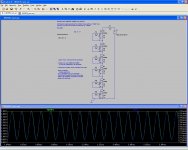This board has always been very informative and knowledgeable, so I'm confident you'll be able to help me with this design.
I need a several hundred kohm (preferably closer to 1M) plate load @ about 30 ... 40 mA, that can withstand voltage swings in the kilovolt range. Idle voltage (DC) accross the plate load can be at most 300 volts, I plan to have a B+ around 1000 volts.
So, there seems to be three ways to go:
1) choke
2) SS
3) pentode
Choise number 1 seems impractical, I don't think such choke exists, or if it does, it'll cost (and weigh) way too much.
As for SS, I don't know much about them. There seems to be some SS devices with reasonable prices and 900 V ratings, perhaps it would be possible to stack them somehow? As I said, SS is not my expertise.
The most interesting choise at the moment seems to be the pentode, perhaps some TV sweep tubes. They seem to have good voltage ratings, and with the low current I'll be running they won't be under strain, but I don't really know if they're suited for the task - like I said, I'd need 500 - 1000 kohms of impedance. I read from some tutorial, that with pentodes, you can approximate the generated impedance as being the rp of the pentode - well, the sweep tubes I looked at have rp's in the 10 - 15 kohm range.
Any suggestions on how to proceed?
I need a several hundred kohm (preferably closer to 1M) plate load @ about 30 ... 40 mA, that can withstand voltage swings in the kilovolt range. Idle voltage (DC) accross the plate load can be at most 300 volts, I plan to have a B+ around 1000 volts.
So, there seems to be three ways to go:
1) choke
2) SS
3) pentode
Choise number 1 seems impractical, I don't think such choke exists, or if it does, it'll cost (and weigh) way too much.
As for SS, I don't know much about them. There seems to be some SS devices with reasonable prices and 900 V ratings, perhaps it would be possible to stack them somehow? As I said, SS is not my expertise.
The most interesting choise at the moment seems to be the pentode, perhaps some TV sweep tubes. They seem to have good voltage ratings, and with the low current I'll be running they won't be under strain, but I don't really know if they're suited for the task - like I said, I'd need 500 - 1000 kohms of impedance. I read from some tutorial, that with pentodes, you can approximate the generated impedance as being the rp of the pentode - well, the sweep tubes I looked at have rp's in the 10 - 15 kohm range.
Any suggestions on how to proceed?
Wavebourn, you are referring to SemiSouth SJDP120R085, right?
http://www.semisouth.com/products/uploads/DS_SJDP120R085_rev1.0.pdf
The simplest CSS I know how to make with that would be a transistor, with a resistor under the source, and the gate connected to the bottom of the resistor. How would I go about calculating 1) the impedance that is generated 2) how much voltage the CSS would drop?
http://www.semisouth.com/products/uploads/DS_SJDP120R085_rev1.0.pdf
The simplest CSS I know how to make with that would be a transistor, with a resistor under the source, and the gate connected to the bottom of the resistor. How would I go about calculating 1) the impedance that is generated 2) how much voltage the CSS would drop?
Choise number 1 seems impractical, I don't think such choke exists, or if it does, it'll cost (and weigh) way too much.
Had you considered using the secondary of an ESL step-up transformer?
It would have a couple of hundred of picofarad, though...
You don't need to calculate voltage drop. You set it, through some 1 megaohm resistor on it's gate. Some 1-10 kiloohm resistor in drain, and a capacitor from anode of your bottom tube to the gate. It is called gyrator, a ccs on AC that provides stable anode voltage to your tube, no matter how big it's anode current is.
I suppose, some Zener to protect the gate from over-voltage, and gate stopper resistor to avoid oscillations would be needed as well.
You don't need to calculate voltage drop. You set it, through some 1 megaohm resistor on it's gate. Some 1-10 kiloohm resistor in drain, and a capacitor from anode of your bottom tube to the gate. It is called gyrator, a ccs on AC that provides stable anode voltage to your tube, no matter how big it's anode current is.
I suppose, some Zener to protect the gate from over-voltage, and gate stopper resistor to avoid oscillations would be needed as well.
SY, often gapless, wouldn't it saturate?
Depends on the connection. I successfully prototyped a direct drive ESL amp by using the secondary of an Acoustat transformer as the plate loads for a push pull stage, with the B+ connected to the CT and the panels connected directly to the plates. Single ended would indeed be a problem.
MrC, depends on what you mean by "expensive." Roger Sanders claimed good results from small tube output transformers- iron similar to what he used is available in the $60-70 range. ESL transformers are more costly, but not enormously so- $150 is typical.
Wavebourn: Thank you!
So if I get this correctly, the gate is connected to 1) tube anode via a cap 2) B+ via a 1M resistor.
Not exactly to B+, but to a bias voltage divider. If to connect to B+ it would saturate. Voltage on this divider defines voltage on anode of your output tube.
- Status
- This old topic is closed. If you want to reopen this topic, contact a moderator using the "Report Post" button.
- Home
- Amplifiers
- Tubes / Valves
- Extreme plate load
